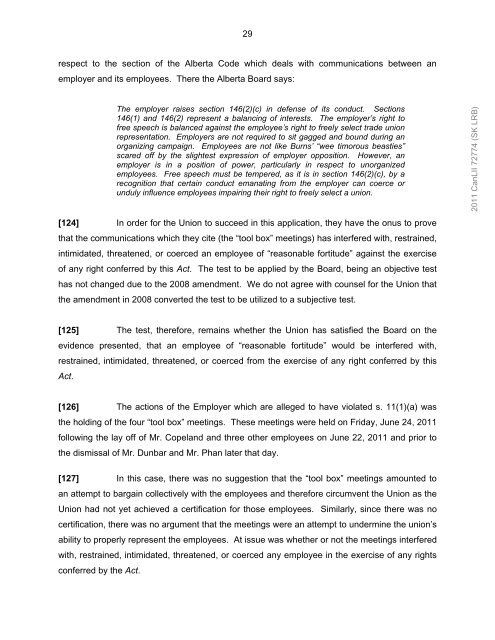FAQ's Cases - Stewart McKelvey
FAQ's Cases - Stewart McKelvey
FAQ's Cases - Stewart McKelvey
- No tags were found...
Create successful ePaper yourself
Turn your PDF publications into a flip-book with our unique Google optimized e-Paper software.
29respect to the section of the Alberta Code which deals with communications between anemployer and its employees. There the Alberta Board says:The employer raises section 146(2)(c) in defense of its conduct. Sections146(1) and 146(2) represent a balancing of interests. The employer’s right tofree speech is balanced against the employee’s right to freely select trade unionrepresentation. Employers are not required to sit gagged and bound during anorganizing campaign. Employees are not like Burns’ “wee timorous beasties”scared off by the slightest expression of employer opposition. However, anemployer is in a position of power, particularly in respect to unorganizedemployees. Free speech must be tempered, as it is in section 146(2)(c), by arecognition that certain conduct emanating from the employer can coerce orunduly influence employees impairing their right to freely select a union.2011 CanLII 72774 (SK LRB)[124] In order for the Union to succeed in this application, they have the onus to provethat the communications which they cite (the “tool box” meetings) has interfered with, restrained,intimidated, threatened, or coerced an employee of “reasonable fortitude” against the exerciseof any right conferred by this Act. The test to be applied by the Board, being an objective testhas not changed due to the 2008 amendment. We do not agree with counsel for the Union thatthe amendment in 2008 converted the test to be utilized to a subjective test.[125] The test, therefore, remains whether the Union has satisfied the Board on theevidence presented, that an employee of “reasonable fortitude” would be interfered with,restrained, intimidated, threatened, or coerced from the exercise of any right conferred by thisAct.[126] The actions of the Employer which are alleged to have violated s. 11(1)(a) wasthe holding of the four “tool box” meetings. These meetings were held on Friday, June 24, 2011following the lay off of Mr. Copeland and three other employees on June 22, 2011 and prior tothe dismissal of Mr. Dunbar and Mr. Phan later that day.[127] In this case, there was no suggestion that the “tool box” meetings amounted toan attempt to bargain collectively with the employees and therefore circumvent the Union as theUnion had not yet achieved a certification for those employees. Similarly, since there was nocertification, there was no argument that the meetings were an attempt to undermine the union’sability to properly represent the employees. At issue was whether or not the meetings interferedwith, restrained, intimidated, threatened, or coerced any employee in the exercise of any rightsconferred by the Act.
















